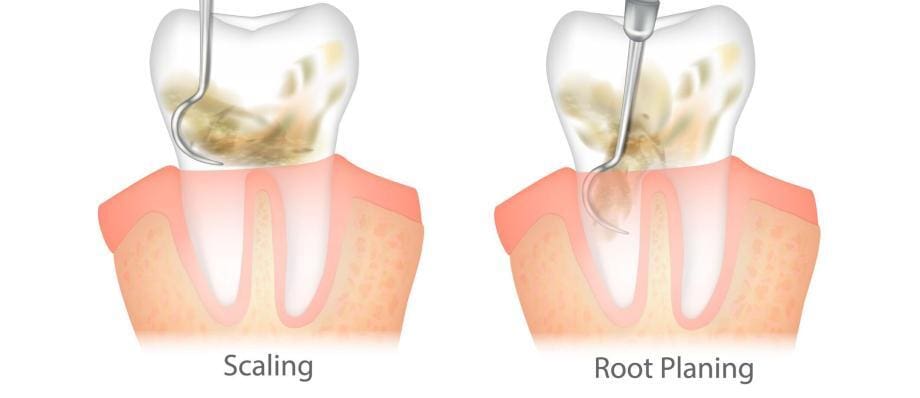Maintaining optimal oral health is crucial for overall well-being. Regular dental visits and good oral hygiene practices, such as brushing and flossing, play a vital role in preventing oral diseases. However, there are instances when routine care may not be sufficient, especially when it comes to treating gum disease. Scaling and root planing, also known as dental deep cleaning, is a non-surgical procedure performed by dental professionals to combat periodontal disease and restore oral health. In this article, we will explore scaling and root planing in detail, including its purpose, procedure, benefits, aftercare, and potential complications.
Understanding Gum Disease and Its Progression
Gum disease, also called periodontal disease, is a prevalent condition characterized by inflammation and infection of the gums. It occurs when bacteria in plaque build up along the gumline and cause an immune response, leading to tissue damage and eventual tooth loss if left untreated. The disease progresses through different stages, including gingivitis and periodontitis.
The Purpose of Scaling and Root Planing
Scaling and root planing is a common treatment approach for gum disease, particularly in its early to moderate stages. The procedure aims to remove plaque, tartar, and bacterial toxins from the tooth surfaces and below the gumline, promoting gum tissue healing and preventing further disease progression. Scaling focuses on the thorough removal of plaque and tartar from the teeth, while root planing smoothes the tooth roots to eliminate rough surfaces where bacteria can easily accumulate.
The Scaling and Root Planing Procedure
- Evaluation and Planning
- Local Anesthesia
- Scaling
- Root Planing
Evaluation and Planning
Before initiating scaling and root planing, a comprehensive examination is conducted to assess the severity of gum disease. Dental professionals may use dental X-rays and periodontal probing to determine the extent of gum tissue damage and identify areas requiring treatment.
Local Anesthesia
To ensure patient comfort during the procedure, a local anesthetic may be administered to numb the gum tissues.
Scaling
The dental professional uses specialized instruments, such as ultrasonic scalers and handheld instruments like curettes, to remove plaque and tartar from the tooth surfaces and below the gumline. Ultrasonic scalers employ vibrations and water irrigation to dislodge and flush out debris effectively.
Root Planing
Following scaling, the tooth roots are carefully smoothed using scaling instruments or ultrasonic scalers. This process eliminates bacterial toxins and creates a clean surface that allows the gums to reattach to the roots.
Benefits and Importance of Scaling and Root Planing
Scaling and root planing offers several benefits, making it an essential treatment for gum disease:
- Halting Disease Progression
- Reducing Pocket Depth
- Improved Oral Health
- Preventing Tooth Loss
Halting Disease Progression
By removing bacteria and their byproducts, scaling and root planing arrest the progression of gum disease, preventing further tissue and bone loss.
Reducing Pocket Depth
Deep pockets between the gums and teeth are a hallmark of advanced gum disease. Scaling and root planing help reduce pocket depth, limiting the space available for bacteria to thrive and cause further damage.
Improved Oral Health
Dental deep cleaning enhances oral health by removing plaque and tartar buildup, leading to improved breath freshness and a cleaner, healthier smile.
Preventing Tooth Loss
By addressing gum disease in its early stages, scaling and root planing can save teeth that might otherwise be lost due to advanced periodontal disease.
Aftercare and Maintenance
After scaling and root planing, patients are typically provided with instructions for post-treatment care, which may include Good Oral Hygiene Practices.
Following scaling and root planing, maintaining good oral hygiene practices is crucial for successful recovery and long-term oral health. Patients should be advised to:
- Brushing
- Flossing
- Antimicrobial Mouthwash
- Regular Dental Check-ups
- Healthy Lifestyle Choices
- Avoiding Irritants
- Stress Management
Brushing
Brush teeth at least twice a day using a soft-bristle toothbrush and fluoride toothpaste. It’s important to use gentle, circular motions and pay attention to the gumline and tooth surfaces.
Flossing
Clean between teeth daily using dental floss or interdental cleaners. This helps remove plaque and food particles from areas that are difficult to reach with a toothbrush.
Antimicrobial Mouthwash
Rinse with an antimicrobial mouthwash recommended by the dentist. This can help reduce bacteria in the mouth and promote healing.
Regular Dental Check-ups
Schedule follow-up appointments with the dentist for professional evaluations and cleanings. This allows monitoring of gum health and early detection of any recurring issues.
Healthy Lifestyle Choices
Adopting a healthy lifestyle, including a balanced diet, regular exercise, and avoiding tobacco use, can positively impact oral health.
Avoiding Irritants
Refrain from consuming tobacco products and limit the intake of alcohol and acidic foods and beverages that can irritate the gums.
Stress Management
Stress can contribute to gum disease. Engaging in stress-reducing activities, such as meditation or exercise, can help maintain overall well-being and support oral health.
It is important for patients to follow these recommendations consistently to prevent the recurrence of gum disease and maintain the results achieved through scaling and root planing.
Potential Complications and Risks
While scaling and root planing is generally considered safe, there are a few potential complications and risks associated with the procedure:
- Sensitivity
- Gum Discomfort
- Infection
- Gum Recession
Sensitivity
Patients may experience temporary tooth sensitivity to hot or cold stimuli. This sensitivity usually subsides within a few weeks.
Gum Discomfort
Following the deep cleaning, some patients may experience mild gum tenderness or discomfort. This discomfort can typically be managed with over-the-counter pain relievers and saltwater rinses as recommended by the dentist.
Infection
In rare cases, an infection may occur if bacteria enter the bloodstream through gum tissue that is compromised due to gum disease. However, this risk is minimal and can be further reduced through proper oral hygiene practices.
Gum Recession
In some cases, the gums may recede slightly after the procedure. This occurs as the gum tissue heals and regenerates. However, significant gum recession is uncommon.
It is important for patients to communicate any concerns or unusual symptoms to their dentist promptly to ensure appropriate care.
Conclusion
Scaling and root planing is a valuable non-surgical procedure for treating gum disease and maintaining oral health. By removing plaque, tartar, and bacteria below the gumline, this deep cleaning technique can halt disease progression, reduce pocket depth, and promote gum tissue healing. With proper aftercare and maintenance, patients can enjoy improved oral health, fresher breath, and a decreased risk of tooth loss. Regular dental check-ups, good oral hygiene practices, and a healthy lifestyle contribute to the long-term success of scaling and root planing. If you suspect gum disease, consult a dental professional who can provide an accurate diagnosis and recommend the most suitable treatment plan, including scaling and root planing if necessary.





